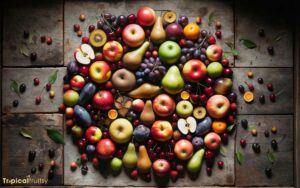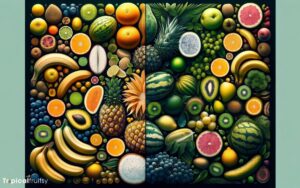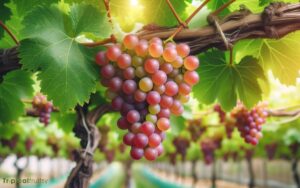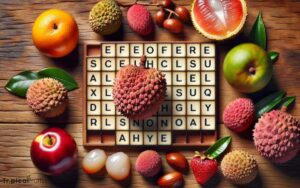World Guide to Tropical Drift Seeds and Fruits: A Guide!
The ‘World Guide to Tropical Drift Seeds and Fruits’ is an authoritative resource dedicated to the study and understanding of the botanical and ecological aspects of seeds and fruits that travel across oceans.
This guide delves into the intriguing phenomenon of how ocean currents act as vectors for seed dispersal, contributing to the widespread distribution of tropical plant species.
It provides a comprehensive examination of the anatomical adaptations that enable seeds to remain buoyant and survive long voyages.
Readers will find detailed descriptions of the diverse species capable of such journeys, alongside discussions of the ecological consequences and the historical context of this natural dispersal method.
The guide also offers practical advice on collecting and identifying these botanical travelers, while underscoring the importance of conservation efforts and ongoing research in this fascinating area of botanical study.
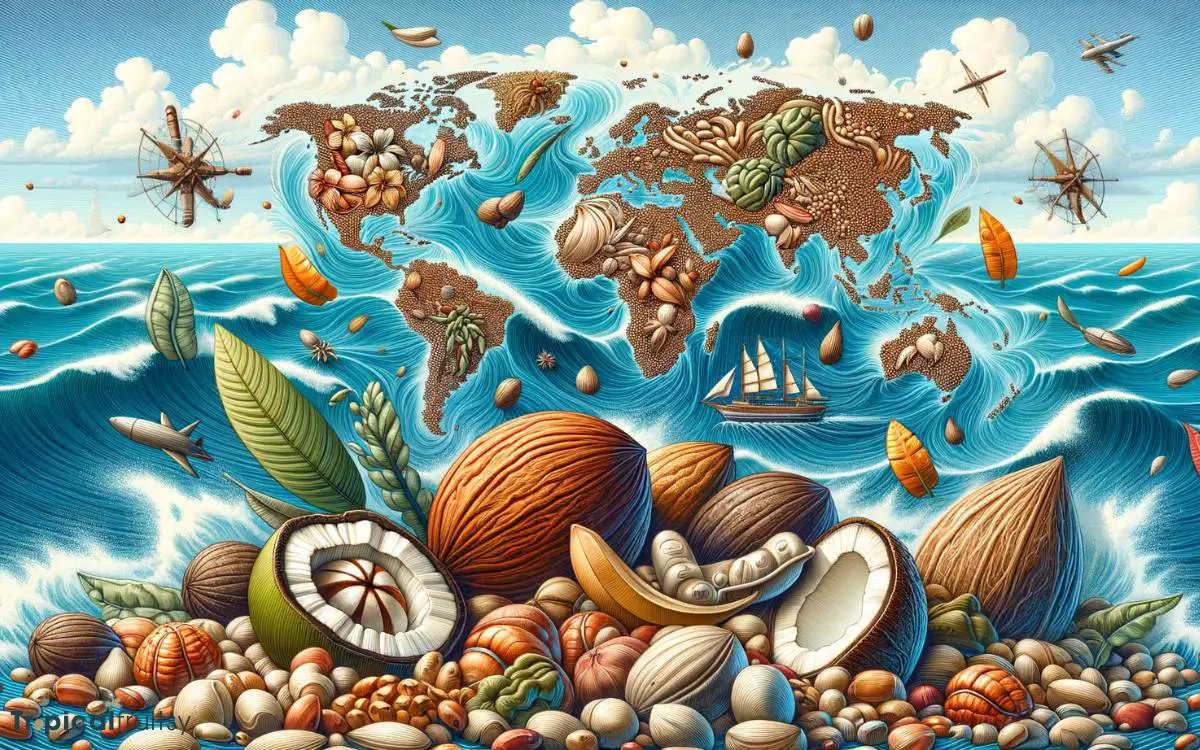
Key Takeaway
The Phenomenon of Drift Seeds

The phenomenon of drift seeds refers to the natural dispersion of seeds and fruits across oceans and water bodies by means of currents and tides.
This process is a critical facet of plant dispersal mechanisms, serving as a primary means for the propagation of various species across vast distances.
Drift seeds typically possess characteristics that facilitate their survival in saline aquatic environments and enhance their buoyancy, such as hard, impermeable outer coatings or internal air spaces.
Through this mode of transport, seeds can colonize new shorelines and contribute to the genetic diversity and ecological dynamics of coastal ecosystems.
Understanding the intricacies of this dispersal strategy is essential for comprehending the biogeographical distribution patterns of tropical flora.
Ocean Currents and Seed Dispersal
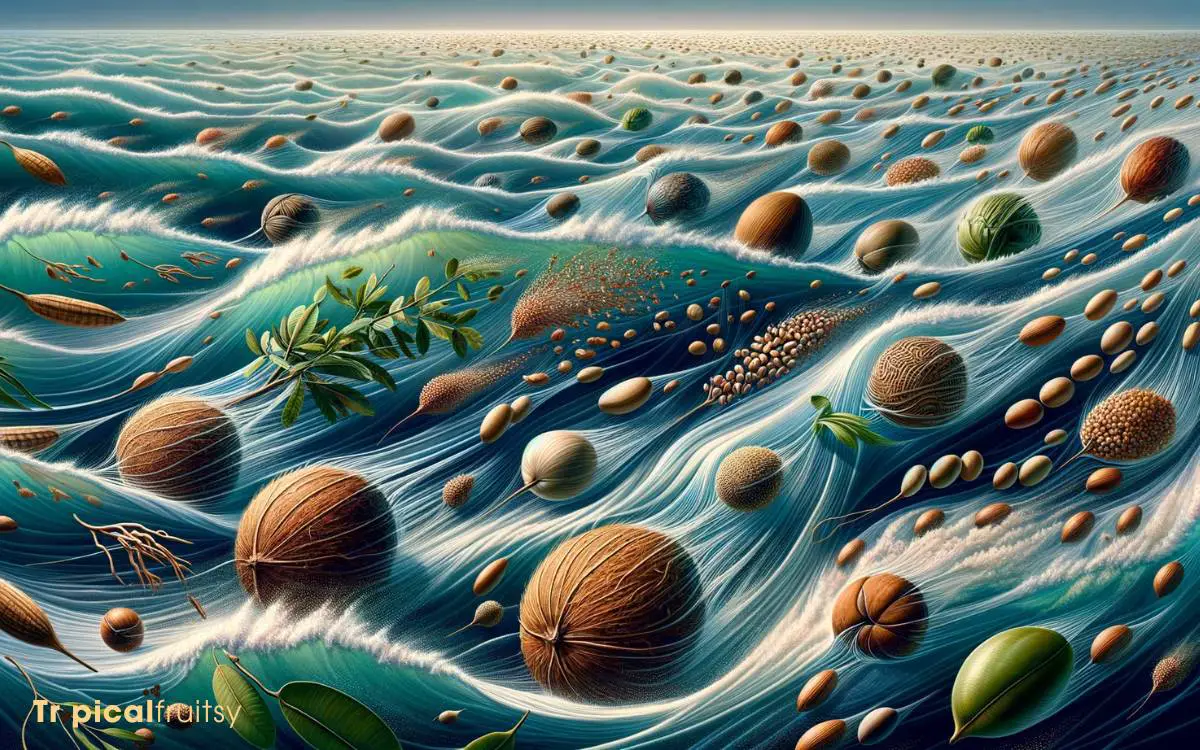
Building upon the concept of drift seeds, ocean currents play a pivotal role in the long-distance dispersal of these buoyant botanical travelers.
The complex network of global marine currents acts as conduits for the distribution of seeds, influencing patterns of vegetative propagation and genetic diversity across vast oceanic distances.
Ocean Currents and Seed Dispersal:
- Gyre Dynamics: Seeds entrapped in subtropical gyres can be transported over thousands of miles. The circular motion prolongs the exposure of seeds to viable landing sites.
- Equatorial Currents: Swiftly move seeds along the equator, facilitating rapid transoceanic journeys.
- Coastal Currents: Often direct seeds to shorelines, impacting the colonization of coastal habitats.
This system of currents, each with its distinct characteristics, intricately shapes the fate and distribution of tropical drift seeds and fruits in marine environments.
Anatomy of a Buoyant Seed
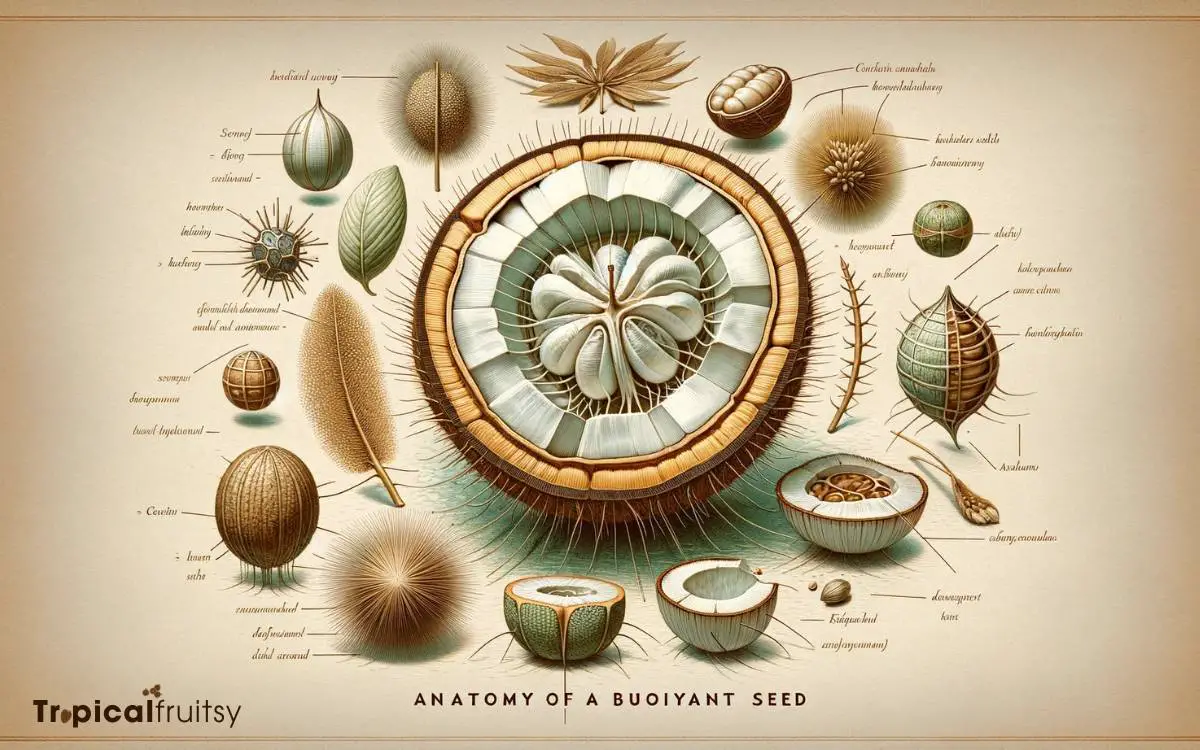
The anatomical features of buoyant seeds are pivotal in facilitating their dispersal by water currents, a process essential for species survival in tropical regions.
Investigating the floatation mechanisms, it becomes apparent that adaptations such as fibrous, air-filled cavities or low-density tissues contribute to their buoyancy.
A detailed examination of the buoyant seed structure, including the seed coat and endosperm properties, is critical to understanding how these seeds withstand long periods in marine environments without compromising viability.
Seed Floatation Mechanisms
Buoyant seeds possess specialized anatomical adaptations that enable them to float and disperse over vast distances across water bodies.
These adaptations are crucial for the reproductive success of many tropical plant species that rely on waterways for seed dispersal.
The mechanisms of floatation are varied and often species-specific, reflecting an intricate evolution towards maximizing dispersal potential.
Anatomical Adaptations:
- Air Spaces: Seeds may contain internal cavities filled with air, effectively reducing their density.
- Fibrous Husks: The presence of spongy, fibrous outer layers can trap air and increase buoyancy.
- Waxy Coatings: Hydrophobic surface layers repel water, aiding in the seed’s ability to float on the water’s surface.
Through these adaptations, seeds exploit the physical properties of water, ensuring their spread to suitable environments for germination and growth.
Buoyant Seed Structure
Within the realm of tropical flora, the structural anatomy of buoyant seeds is a testament to their specialized adaptations for waterborne dispersal.
These seeds typically possess features like fibrous husks or air-filled cavities that enhance their buoyancy.
The fibrous material not only provides floatation but also protection from saltwater intrusion during potentially prolonged oceanic voyages.
The integument, or seed coat, is often impermeable, thus safeguarding the embryonic plant from deleterious hydration and pathogens.
Furthermore, the density and size of these seeds are calibrated to facilitate their suspension atop water currents, optimizing their chances for colonization.
The morphological characteristics of buoyant seeds underscore a sophisticated natural selection process. This evolutionary ingenuity paves the way to explore the diversity of drifting species in the subsequent section.
Diversity of Drifting Species

Tropical oceans serve as a conduit for an array of species that have adapted their seeds and fruits to drift vast distances on marine currents.
This diversity is not arbitrary; it is the result of evolutionary pressures that favor dispersal mechanisms aligning with the dynamic marine environment.
The drifting species exhibit a remarkable range of adaptations that facilitate their survival and dispersal across vast oceanic expanses.
Anatomical Adaptations:
- Buoyant structures: Fibrous husks and air pockets
- Hydrophobic surfaces: Waxy coatings to repel water
- Elongated shapes: Streamlined forms to aid oceanic travel
These traits enhance the probability of successful colonization in new habitats, ensuring genetic diversity and species resilience.
The study of these adaptations is critical for understanding the ecological and evolutionary processes that govern plant distribution in marine environments.
Ecological Impacts of Seed Voyage

The dispersal of countless seeds and fruits via ocean currents significantly influences the biodiversity and ecological dynamics of coastal ecosystems.
These buoyant propagules can travel vast distances, leading to gene flow among plant populations across disparate geographic locales.
This genetic exchange is crucial for maintaining species resilience and adaptability in the face of environmental changes.
Moreover, the arrival of new species into coastal habitats can lead to novel plant assemblages, impacting local flora and fauna.
| Factor | Effect on Coastal Ecosystems | Implication for Biodiversity |
|---|---|---|
| Long-distance dispersal | Enhances genetic diversity | Increases resilience |
| Novel species introduction | Can lead to competitive displacement | Alters community structure |
| Gene flow | Promotes adaptability to change | Supports evolutionary potential |
| Habitat colonization | Influences succession dynamics | Shapes ecosystem development |
| Seedling recruitment | Determines species distribution | Affects habitat complexity |
Analyzing these phenomena reveals the intricate linkages between oceanic seed dispersal and the long-term sustainability of tropical coastal ecosystems.
Historical Significance and Study

Historical analysis sheds light on how the study of tropical drift seeds and fruits has evolved, revealing its importance in understanding global botanical distribution patterns and maritime history.
The systematic cataloging and analysis of such seeds have provided insights into ancient trade routes and currents, historical biodiversity levels in various regions, and the migration patterns of ancient peoples.
This meticulous research has facilitated a deeper comprehension of how seeds have traversed vast oceanic distances, influencing not only the spread of plant species but also human culture.
The precise identification of these seeds, often through morphological characteristics and genetic analysis, is crucial for reconstructing past ecological landscapes and understanding anthropogenic impacts on them.
Thus, the historical study of drift seeds is integral to both the fields of botany and archaeology.
Collecting and Identifying Drift Seeds
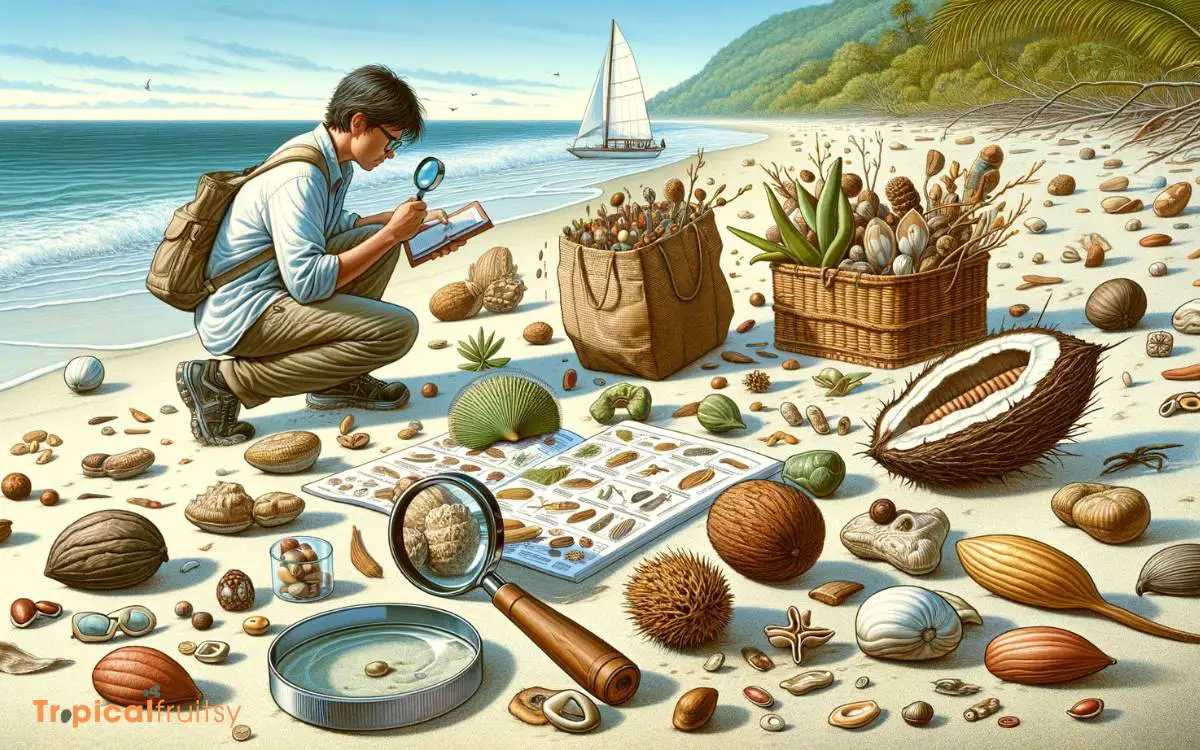
The systematic collection and accurate identification of tropical drift seeds and fruits are fundamental for advancing our understanding of their distribution, ecology, and evolutionary biology.
Seed identification techniques must be robust, utilizing morphological characteristics and, where possible, genetic markers to ensure precise taxonomy.
Implementing best practices for collecting, alongside meticulous preservation and storage methods, is critical to maintain the integrity of samples for future analysis and study.
Seed Identification Techniques
Within the realm of botanical studies, accurate identification of tropical drift seeds and fruits necessitates a methodical approach to both collection and examination.
An analytical, scientific, and detailed methodology often involves:
Initial Sorting
- Visual inspection for distinctive features
- Separation based on size, shape, and color
- Preliminary grouping by suspected species or genus
Morphological Analysis
- Measurement of dimensions and weight
- Microscopic examination of surface textures and patterns
- Comparison with existing taxonomic keys
Genetic Testing (when necessary)
- DNA extraction and sequencing
- Molecular analysis to confirm species
- Cross-referencing with genetic databases
Such precision in identification is foundational for understanding the origins and spread of these botanical travelers.
Moving forward, we will explore the ‘collecting best practices’ that underpin the efficacy of these techniques.
Collecting Best Practices
Effective seed-collection protocol is pivotal in ensuring the accuracy of tropical drift seed identification and subsequent scientific analysis.
Collectors must rigorously document the geographic coordinates and environmental conditions at the collection site. It is essential to preserve the integrity of the seeds by minimizing handling and exposure to contaminants.
Using clean, inert tools for collection and storing the specimens in breathable containers can prevent mold growth and degradation. Accurate labeling with date, location, and collector’s name is crucial for traceability.
A detailed field log should accompany the specimens, noting any peculiarities in morphology or appendages that could aid in identification.
High-resolution photographs of the seeds, including scale reference, can serve as invaluable supplemental data for later examination.
Preservation and Storage Methods
Upon collecting tropical drift seeds, it is imperative to implement proper preservation and storage techniques to maintain their condition for accurate identification and analysis.
These methods are crucial for ensuring the seeds’ morphological characteristics are not compromised.
Preservation and storage strategies include:
Environmental Control
- Humidity: Maintain low humidity to prevent mold growth.
- Temperature: Store in a cool, stable environment to reduce metabolic activity.
Physical Handling
- Gentle Cleaning: Remove salt and debris without damaging the seed coat.
- Minimal Contact: Handle seeds with care to avoid abrasions.
Long-term Storage
- Airtight Containers: Use to shield from environmental fluctuations.
- Labeling: Ensure detailed labeling for future reference and studies.
- Database Entry: Input data into a specialized database for accessible tracking and research.
Are Avocados Considered Tropical Drift Seeds or Fruits?
Avocado as tropical fruit is indeed a tropical drift seed, as it belongs to the Lauraceae family. However, botanically speaking, avocados are classified as fruits due to their fleshy interior and large seed. They are often associated with tropical climates, but their true nature lies within their fruit classification.
Conservation and Future Research

Conservation efforts for tropical drift seeds and fruits require rigorous scientific research to inform sustainable practices and biodiversity preservation.
These propagules, often dispersed over vast oceanic distances, play a crucial role in the resilience and genetic diversity of coastal ecosystems.
To ensure their effective conservation, future research must focus on understanding the ecological dynamics of their dispersal mechanisms, germination rates under varying environmental conditions, and the potential impacts of climate change on their distribution patterns.
Detailed genetic studies could unravel evolutionary adaptations, while long-term monitoring programs are essential to detect shifts in abundance and species composition.
Furthermore, collaborations with local communities and stakeholders are vital for successful conservation measures, integrating indigenous knowledge with scientific findings to optimize habitat protection and management strategies for these botanical wanderers.
Conclusion
The study of tropical drift seeds and fruits provides vital insights into the resilience and adaptability of plant species within marine ecosystems.
It is estimated that some seeds can travel over 5,000 kilometers, a testament to their evolutionary ingenuity.
This research not only enhances understanding of plant dispersal mechanisms but also informs conservation strategies, ensuring the sustainability of these species amidst changing environmental conditions and human impacts on ocean currents.

